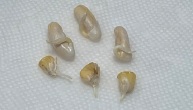Earth Science Week Classroom Activities
Seeding Growth
Activity Source:
Society of Exploration Geophysicists. Adapted with permission.
Much of the food that people eat is produced as crops grown from seeds. What does it take for a seed to grow? How does a seed start to grow? What changes occur as it grows?
Understanding the growth of seeds can help us understand food production, which is basic to understanding the issue of hunger in the world.
Materials
For each group:
- 10 dried beans
- 10 dried corn seeds
- 2 small plastic cups
- 4 paper towels
- 2 plates or trays
- Water
- Scale (grams)
Procedure
1. Use a scale to find the mass of 10 dried beans. Record the mass. Do the same with 10 dried corn seeds.
2. Put the beans you massed in one cup and the corn seeds you massed in another cup.
3. Fill each cup with water.
4. After about 24 hours, remove the beans from the cup and place them on a paper towel.
- Place the paper towel and seeds on a plate or tray.
- Use the water from the cup to wet the paper towel.
- Repeat with the corn seeds on a different paper towel.
5. Compare the soaked beans and soaked corn seeds to some that are still dry. What do you notice about them? How have the soaked beans and soaked corn seeds changed?
6. Measure the mass of the soaked beans and the soaked corn seeds. How has each group’s mass changed?
7. From what you observe and measure, write a statement about how soaking the beans and seeds affected them.
8. Loosely wrap the soaked beans in one wet paper towel and the soaked corn seeds in another.
9. Take the mass of the soaked beans and soaked corn and make observations every day until stems or roots have started to grow out of the seeds. Keep the paper towels moist.
10. What do you observe after several days? When you remeasure the mass of the beans and corn, what do you notice?
11. Place five of the beans back in the wet paper towel. Place the other five in a dry paper towel. Repeat this with the corn seeds.
12. Take the mass of the beans and corn and make observations for 10 more days.

Credit: AGI/L. Mossa
Consider
- Think about other ways that you could make observations. What could you do to the beans and corn seeds to learn more about the effect water has on them?
- Did the beans and seeds require water to start growing? Did the beans and corn require water to continue growing? Use your data to support your answers. What does this tell you about the role of water seed growth?
- Why do farmers regularly water their crops?
- Do you think it is possible for plants to get too much water? How would you test this? What observations would you make that would tell you plants are getting too much water? If possible, test out your ideas!
NGSS CONNECTIONS
Science and Engineering Practices – Obtaining, Evaluating, and Communicating Information; Analyzing and Interpreting Data
Disciplinary Core Ideas – Earth Materials and Systems; The Roles of Water in Earth’s Surface Processes
Crosscutting Concepts – Cause and Effect; Stability and Change
SDG CONNECTIONS
- 2: Zero Hunger
- 6: Clean Water & Sanitation
- 15: Life on Land
